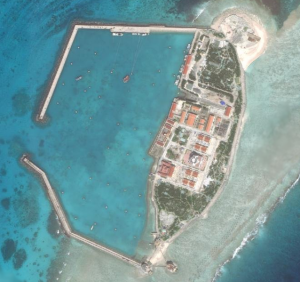
Introduction
Beginning on May 6, India launched what it calls “Operation Sindoor“, striking multiple targets in Pakistan that it claims are “terrorist infrastructure”, in retaliation for the April 22 attack on the Pahalgam resort are in Indian-controlled Kashmir. Radical Islamist jihadists massacred 26 men – 24 Hindus, one Christian, and one Muslim who tried to stop them – in front of their families. This has terrified the nations of the world, as both India and Pakistan have nuclear arsenals of ~180 warheads, each…and the potential for a nuclear exchange is very high.

As we reported in January, the “weakest link” in this equation remains Pakistan: Unable to maintain control of it’s creations – the Taliban in both Afghanistan and in Pakistan itself – as well as Lakshar-e-Taiba and its clone, The Resistance Front (TRF) (the group responsible for the Pahalgam attack), Pakistan is also losing control of its Balochistan province to regional separatists, as it struggles to contain multiple threats, mostly of its own making, while others – like the TRF – have now provoked India into military-scale violence.
The dispute over Jammu and Kashmir represents one of the most enduring territorial conflicts in modern history, entangling India and Pakistan in a complex web of historical, religious, and geopolitical tensions since their independence from British rule in 1947. Alongside this territorial conflict, the countries faced another critical challenge: sharing the waters of the Indus River system, ultimately resolved through the landmark Indus Waters Treaty of 1960.
Origins of the Kashmir Dispute
Colonial Roots and Partition (1846-1947)
The foundations of the conflict trace back to 1846 when the British East India Company, following their victory in the First Anglo-Sikh War, sold Kashmir to Gulab Singh, the Dogra ruler of Jammu, through the Treaty of Amritsar. This established the princely state of Jammu and Kashmir under Dogra rule, despite its Muslim-majority population.

When British India was partitioned in August 1947, the fate of its princely states, including Jammu and Kashmir, was left to their respective rulers. Despite having a Muslim-majority population, Jammu and Kashmir was ruled by Maharaja Hari Singh, a Hindu. Caught between accession to India or Pakistan, Singh initially sought independence. However, when tribal raiders from Pakistan’s Northwest Frontier Province invaded Kashmir in October 1947, the Maharaja signed the Instrument of Accession with India in exchange for military assistance.
This pivotal decision ignited the First Indo-Pakistani War (1947-48). The conflict ended with a UN-brokered ceasefire in January 1949, leaving Kashmir divided along what became known as the Line of Control (LoC). India controlled approximately two-thirds of the territory, including the Kashmir Valley, Jammu, and Ladakh, while Pakistan administered the remaining third, known as Azad (Free) Kashmir and the Northern Areas (now Gilgit-Baltistan).
The UN resolutions calling for a plebiscite to determine Kashmir’s final status were never implemented due to disagreements over the conditions for such a vote. India maintained that Pakistan must first withdraw its forces, while Pakistan insisted that India should reduce its military presence before any referendum.
Subsequent Conflicts and Changing Dynamics
The unresolved Kashmir issue led to further wars between India and Pakistan in 1965 and 1971, though the latter focused primarily on the independence of East Pakistan’s (now Bangladesh). The 1972 Simla Agreement established the LoC as the de facto border and committed both nations to resolve their differences peacefully.
The dispute took a darker turn in the late 1980’s with the emergence of an armed insurgency in Indian-administered Kashmir. Pakistan provided moral and material support to the separatist movement, while India deployed substantial military forces to counter it. The conflict became increasingly militarized, with accusations of human rights abuses on both sides.
The 1999 Kargil War, a limited conflict sparked by Pakistani infiltration across the LoC, further strained relations. The post-2001 era saw sporadic peace initiatives alternating with periods of heightened tensions, particularly following terrorist attacks in India allegedly linked to Pakistan-based groups.

And then…there is Article 370.
Article 370: An Unnecessary Knife-Twist
Article 370 was a special provision in the Indian Constitution that granted Jammu and Kashmir significant autonomy within the Indian Union. Enacted in 1949 as a “temporary provision,” it allowed the state to have its own constitution, flag, and considerable independence in all matters except foreign affairs, defense, and communications.
The provision emerged from the unique circumstances of Kashmir’s accession to India. When Maharaja Hari Singh signed the Instrument of Accession in 1947, it was with the understanding that Kashmir would retain substantial autonomy. Article 370 formalized this arrangement, restricting the Indian Parliament’s legislative powers over the state and requiring consultation with the state government for extending constitutional provisions beyond the agreed domains.
Over time, Article 370’s implementation evolved. Through presidential orders, particularly in 1954, many provisions of the Indian Constitution were gradually extended to Jammu and Kashmir. Article 35A, introduced through this mechanism, allowed the state legislature to define “permanent residents” and grant them special privileges regarding property rights and government employment.
For seven decades, Article 370 remained a politically charged issue. Supporters viewed it as honoring India’s commitment to Kashmir’s distinct identity, while critics saw it as an obstacle to full integration and development.
On August 5, 2019, the Indian government, led by Prime Minister Narendra Modi, effectively nullified Article 370 through presidential orders and parliamentary legislation. The state was simultaneously reorganized into two union territories: Jammu and Kashmir (with a legislature) and Ladakh (without one). This dramatic constitutional restructuring fundamentally altered Kashmir’s relationship with the central government and remains deeply contested both domestically and internationally.
The Indus Waters Treaty: A Rare Success in Water Diplomacy…With Implications
Against this backdrop of territorial conflict, both countries faced another pressing challenge: sharing the waters of the Indus River system, which originates in Tibet and flows through both countries. The Indus and its tributaries are vital for agriculture, energy production, and water supply in both nations.
Facilitated by the World Bank, the Indus Waters Treaty was signed on September 19, 1960, by Indian Prime Minister Jawaharlal Nehru and Pakistani President Ayub Khan. The treaty allocated the eastern rivers (Ravi, Beas, and Sutlej) to India and the western rivers (Indus, Jhelum, and Chenab) to Pakistan, though India retained limited rights to use the western rivers for non-consumptive purposes, irrigation, and hydroelectric power.

The treaty established the Permanent Indus Commission to address disputes and facilitate communication on water-related issues. It also included provisions for the construction of replacement works to compensate Pakistan for the loss of water from the eastern rivers.
Remarkably, the Indus Waters Treaty has survived three wars and numerous crises in Indo-Pakistani relations until now. It stands as a testament to the potential for cooperation even amid broader conflicts, though it has faced increasing strain in recent decades due to growing water scarcity, climate change, and dam construction projects.
Legacy and Contemporary Challenges
The Kashmir dispute remains unresolved, with both countries maintaining their respective claims to the entire territory. The region’s strategic importance has only increased with China’s growing influence in parts of Kashmir controlled by Pakistan, creating a complex trilateral dimension to the conflict.
Meanwhile, the Indus Waters Treaty, despite its durability, faces mounting pressures. India’s construction of dams on the western rivers, though technically permissible under the treaty, has raised concerns in Pakistan about reduced water flow. Climate change threatens the Himalayan glaciers that feed the Indus system, potentially exacerbating water scarcity and heightening tensions over the existing allocation framework.
The intertwined histories of the Kashmir dispute and the Indus Waters Treaty illustrate both the challenges and possibilities of Indo-Pakistani relations—a narrative of persistent conflict alongside pragmatic cooperation necessitated by shared geographical realities.
Pakistan’s Political Instability: A Dangerous Variable
Pakistan is experiencing significant political instability, with 2024 being one of the most violent years in over a decade. The February elections failed to restore order and were marred by allegations of military manipulation to keep former Prime Minister Imran Khan and his party out of power. This contentious domestic political situation creates opportunities for militants to exploit local anger and makes it more difficult for the government to mount a unified challenge against these groups.
The Pakistan Democratic Movement (PDM) government faces multiple internal challenges, including skyrocketing commodity prices and difficulties finalizing deals with the International Monetary Fund to stop the devaluation of the rupee. This economic pressure has eroded public confidence in the current government.
In the security sphere, multiple groups are eroding Pakistan’s internal stability, with the “Pakistani Taliban” and ISIS-K, as well as a number of Balochi groups, are all vying to either carve out their own sections of Pakistan, or to seize outright control of the entire nation – and its nuclear arsenal. And all the while, the mainline Taliban are also sharpening their knives, looking to dismember the entire Pakistani state. In this, those groups have been greatly aided by the failures of the Biden administration in 2021, which left behind vast amounts of advanced military equipment for the taking.
Looking into 2025, Pakistan continues to grapple with a volatile political and economic environment characterized by political paralysis, fragmented coalitions, and increasing military influence that hinders effective governance. This combination of political fragmentation, economic crisis, and rising security challenges combined to create a volatile mix of factors with significant regional implications.
The Nuclear Dimension: Stakes at Their Highest
Both India and Pakistan have built up nuclear arsenals primarily designed to prevent wars, not start them. India maintains a “no first use” policy, meaning it will only use nuclear weapons in retaliation for a nuclear attack on Indian forces or territories. Pakistan, however, has a “full spectrum deterrence” policy aimed at using tactical nuclear weapons to counter both nuclear threats and conventional military attacks from India.

The nuclear stakes are enormously high – even a small nuclear exchange between India and Pakistan could kill 20 million people in a week. If such an exchange triggered even a minor “nuclear winter”, nearly 2 billion people in the developing world would be at risk of death by starvation.
The introduction of nuclear weapons in 1974 fundamentally changed the dynamic of the India-Pakistan conflict, raising the stakes of any confrontation. India’s first nuclear test that year triggered an arms race that eventually saw Pakistan develop its own nuclear capabilities two decades later.
Pakistan’s Defense Minister Khawaja Muhammad Asif recently stated that Pakistan would only use its nuclear weapons if “there is a direct threat to our existence.” However, he has also warned that Pakistan’s military has been reinforced because an Indian military incursion is “imminent” following the recent attack in Kashmir.
The Water Crisis: An Exitential Dimension to Conflict
The April 22, 2025 terrorist attack in the popular tourist destination of Pahalgam in Indian-administered Kashmir, killed 26 vacationing tourists. The attack was claimed by a group called The Resistance Front (TRF), which Indian authorities claim is closely linked to the Pakistan-based militant group Lashkar-e-Taiba.

The Indus Waters Treaty suspension by India follows the recent terrorist attack in Pahalgam, Kashmir. Pakistan has deemed this suspension illegal, with significant implications for its agriculture and economy. About 80% of Pakistan’s cultivated land relies on the Indus river system.
In response to the attack, India announced the immediate suspension of the Indus Waters Treaty, something not done in the more than 60 years of the treaty’s existence. The Indian government stated the treaty will remain suspended “until Pakistan credibly and irrevocably abjures its support for cross-border terrorism.” India has closed its main land border with Pakistan at Attari and ordered Pakistani nationals in India to leave the country within 48 hours. India is also reducing diplomatic staff at both missions from 55 to 30 personnel and has expelled military advisors from Pakistan’s embassy in New Delhi…In effect, India has had enough of Pakistan supporting anti-Indian insurgents.
Pakistan has responded to India’s moves with its own countermeasures:
Pakistan has closed its airspace to all Indian airlines, and suspended all trade with India, including through third countries, and halted special South Asian visas issued to Indian nationals. Pakistan has also rejected India’s suspension of the Indus Waters Treaty, with officials stating that any attempt to stop or divert water belonging to Pakistan would be considered “an act of war”.
The Indus Waters Treaty suspension is particularly significant because the treaty gave Pakistan unrestricted access to the waters of the three western rivers—Indus, Jhelum, and Chenab—which account for nearly 70% of the total water flow in the Indus river system. Around 80% of Pakistan’s cultivated land, approximately 16 million hectares, depends on water from this vast river network.
Military Modernization: Raising the Stakes
Both India and Pakistan have acquired new military hardware since their last major clash in 2019, opening up new conventional strike options. India has inducted 36 French-made Rafale fighter jets with advanced capabilities, while Pakistan has acquired J-10 fighters from China. Both sides have also upgraded their air defense systems.
Donald Trump’s United States now faces the challenge of balancing its support for India with calls for restraint from Pakistan. With both nations holding nuclear weapons, the risk of escalation is high, and Washington will likely push for diplomatic solutions to de-escalate the crisis.
The current crisis represents the biggest breakdown in India-Pakistan relations since 2019, when a suicide bombing killed 40 Indian soldiers in Kashmir. The current situation follows a pattern where flare-ups between the countries have seen targeted attacks and reprisals, escalating slowly while giving each side the option to step back and defuse. However, the current nature of the strategic moves are of a severity not seen since 1971.
Conclusion
While both sides are desperate to moderate the fighting, the better to avoid the nuclear threshold, Pakistan’s internal instability implies the possibility that external forces in Afghanistan could take this moment to strike Pakistan from the opposite border. The potential impact is hard to model, but should a major land conflict arise, it is possible that Pakistan’s government could collapse, bringing control of its nuclear arsenal into question.

BREAKING Update: Operation Sindoor
On May 6, India launched “Operation Sindoor,” conducting missile strikes in Pakistan and Pakistan-administered Kashmir. Reports indicate there were at least 24 strikes across nine target locations, with explosions heard across Kashmir. These strikes were in direct retaliation for the April 22nd attack on a resort in Pahalgam, a picturesque town in the Himalayas of Indian-controlled Kashmir, which killed some 26 tourists, infront of their families.
The operation targeted six locations in Pakistani-administered Kashmir (Muzaffarabad and Kotli) and Pakistan’s Punjab province (Bahawalpur), crossing both the Line of Control and the international border. India describes the strikes as “focused, measured, and non-escalatory.”
The casualties and damage reported, to 5.7.2025:
Pakistan claims at least 26 civilians were killed and 46 injured by India’s strikes, including teenagers and children, with the youngest victim being three years old. Twelve civilians in Indian-administered Kashmir were also reportedly killed by Pakistani shelling from across the border.
The strikes hit what India calls “terrorist infrastructure” sites, some allegedly linked to the attack that killed 25 Hindu tourists and one local in Indian Kashmir last month. The name “Sindoor” is significant – it refers to the red powder Hindu women apply to their foreheads when married.
Pakistan’s response:
Pakistan has called India’s strikes an “act of war” and stated it would respond. Pakistani forces have already exchanged gunfire with Indian forces along the Line of Control.
As both countries’ leaders held crisis meetings, the UN Secretary-General has expressed “deep concern” over the strikes, and several nations including the US, UAE, China, and Japan have called for de-escalation.
This represents the worst fighting in more than two decades between these nuclear-armed neighbors. The situation is still developing rapidly, with Pakistan promising to retaliate “at a time, place and manner of its choosing.” Major airlines are now avoiding Pakistani airspace as tensions remain high.
The Freedomist is continuing to monitor events as they evolve.
ADDITIONAL RESOURCES
- Julian Thompson (1994), Lifeblood of War: Logistics in Armed Conflict
- Thomas Ricks (2012), The Generals
- James F. Dunnigan (2003), How To Make War, 4th Edition
- James F. Dunnigan (1991), Shooting Blanks








